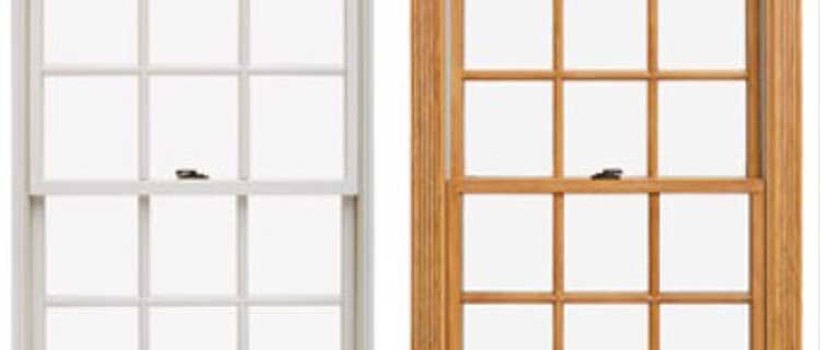Today we will compare and contrast the two leading types of replacement windows, wood windows, and vinyl windows, to help you decide which window material is perfect for you and your home. Any type of replacement windows will make a dramatic difference in your home. Whether it is improving energy efficiency, updating the décor, or adding value to your home, getting old windows replaced has many benefits. However, it is vitally important that you identify the type of window that best fits your home and your personal needs. When we compare the two we will be talking about the bones of the window, not the glass, grilles, handles, locks, etc.
First, we’ll give an overview of each type and then compare them in a handy chart below. So let’s get started — what is a vinyl window anyway?
Choosing Vinyl Windows
Vinyl Windows are windows made out of a plastic material, PVC. Vinyl windows were first developed in the 1970s, to compete against costlier wood windows. Despite their relative youth, vinyl windows now account for roughly the same market share as wood windows. Most people can recognize vinyl windows thanks to an initial uniformity in craftsmanship; they are white windows made out of a plastic material. Only within the past two decades have vinyl windows come in other colors than white.

They are so popular now because they are the most affordable. Some brands are as much as half the price of their wood counterparts. Vinyl windows aren’t as durable as wood windows, but they can last over 20 years. A quality vinyl window will also save you money on energy bills because the insulation in the frame of the window itself is energy efficient. Additionally, vinyl windows require no maintenance because they never need painting or scraping. Overall, vinyl windows give you a great bang for your buck. Yet, regardless of all these benefits, wood windows remain the gold standard in the replacement window industry. But why?
Choosing Wood Windows
Wood Windows are still the “best” type of windows available, especially with virtually all companies offering composite or aluminum-cladded exteriors.* (See below for more detail on window exteriors.) Wood windows are the most beautiful, durable, and energy-efficient windows you can buy. The wood interior drastically improves the aesthetics of your home and can be the main selling point to potential buyers. Many companies have super custom wood window product lines, such as E-Series by Andersen, which have hundreds of color, style, grille, and hardware configurations to match your dream home.

Perhaps more importantly, most wood windows have a warranty of up to fifty years that is transferable from owner-to-owner, so if you use wood windows it will probably be the last time you even think about your windows. The strength of the wood and the exterior cladding prevents weather damage, seals in the heat/cold, and contortion due to hot and cold temperatures. However, if you get wood windows that are not cladded on the outside, you will have to repaint the windows every few years. Wood windows are even more energy-efficient than vinyl, and now with the Fibrex exteriors that some manufactures—like Andersen windows—use, they are just as maintenance-free as vinyl. BUT, all of this greatness comes with a price, of course. Wood Windows are more expensive than vinyl windows because they are more expensive to manufacture and have more added benefits.
Wood vs Vinyl Windows
Wood windows provide the widest alternatives and a more traditional, conventional appeal when it comes to appearance. They are most typically found in historic properties where the appearance of the window is most important. They are available in a variety of wood types, with pine being one of the most affordable and often used. Vinyl windows, on the other hand, offer fewer alternatives. This is because the more ridges and faux wood grain vinyl has, the more dirt it collects over time. As a result, the majority of them have a smooth finish, giving them a plastic appearance. They offer fewer customizing possibilities, but they do come in a variety of frame sizes and thicknesses, which can impact how they appear and operate over time.
Both wood and vinyl windows have the potential to save energy. Vinyl has the advantage of being hollow or filled with foam, which improves its insulating characteristics. Wood that has not been properly maintained may split or decay, allowing heat and cold to travel through. Other materials, such as wood and glass, expand and compress significantly less than vinyl. This expansion and contraction may cause the frame to distort over time, resulting in an air gap and diminishing efficiency. Vinyl windows cannot be repaired, however, wood windows can be repaired. This problem can only be solved by replacing the windows.
Vinyl is the less costly of the two types of windows to buy and install. Materials for a 48-inch vinyl sash window range from $520 to $730 per window. Installing a window costs around $250, bringing the total cost to $770 to $980. Materials for a 48-inch wood sash window range from $750 to $900 per window. The cost of installation of this is roughly $300, bringing the total cost per window to around $1,050 to $1,200.
So What Type of Window Should I Buy?
It all comes down to priorities. If your biggest concern is price, and you are on a very tight budget, vinyl windows are the way to go. If your concern is longevity, beauty, or adding resale value to your home then wood windows are the right choice.
Want a product specialist to help you decide what replacement windows are best for you — click here to schedule an in-home consultation!
* "Cladded-Exteriors" refers to what is covering the outside of the window. On wood windows, the part exposed to the weather is wrapped with another material than wood, to protect it from the elements. When wood windows weren't cladded, the outside of the window had to constantly be repaired and repainted. So, window manufacturers slowed this problem by layering the part of the window exposed to the elements with protective material. Most window companies use aluminum cladding, which is problematic because aluminum conducts heat or cold. A composite (plastic mix, like vinyl) cladding is the best cladding because it doesn't conduct heat/cold and is maintenance-free. Yet that is still just a layer of a protective material (think wrapping paper on the present) and can break down over time and exposure. So, Andersen Windows developed a wood window with an outside piece that is not wood at all, but a whole piece of a composite called Fibrex. It is the best protection you can get and is the next evolution of wood windows.
If you have more questions about Wood vs Vinyl Windows — click here to ask ACRE Windows and Doors a question!





